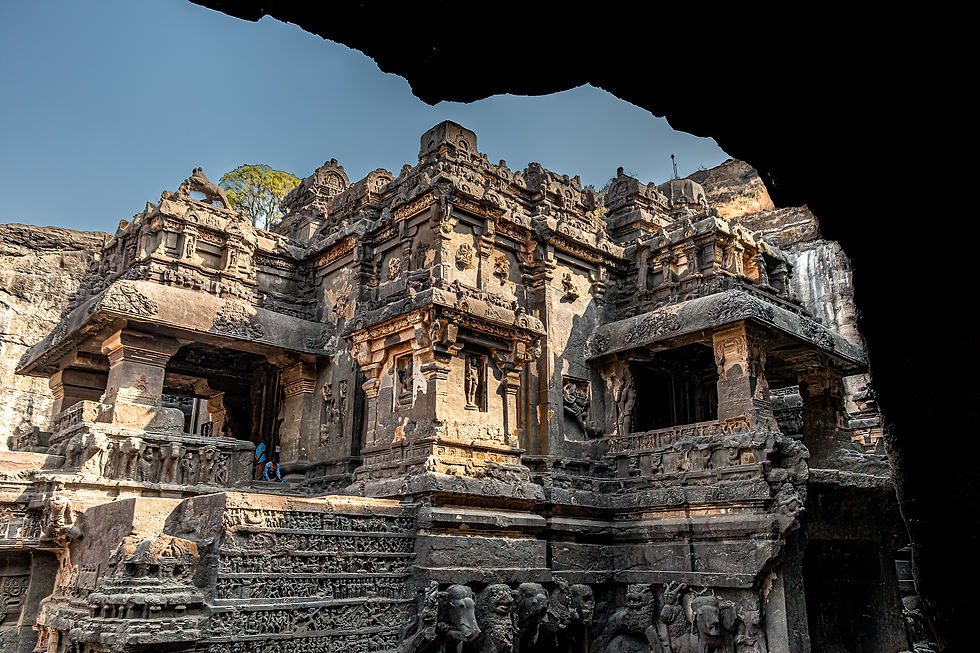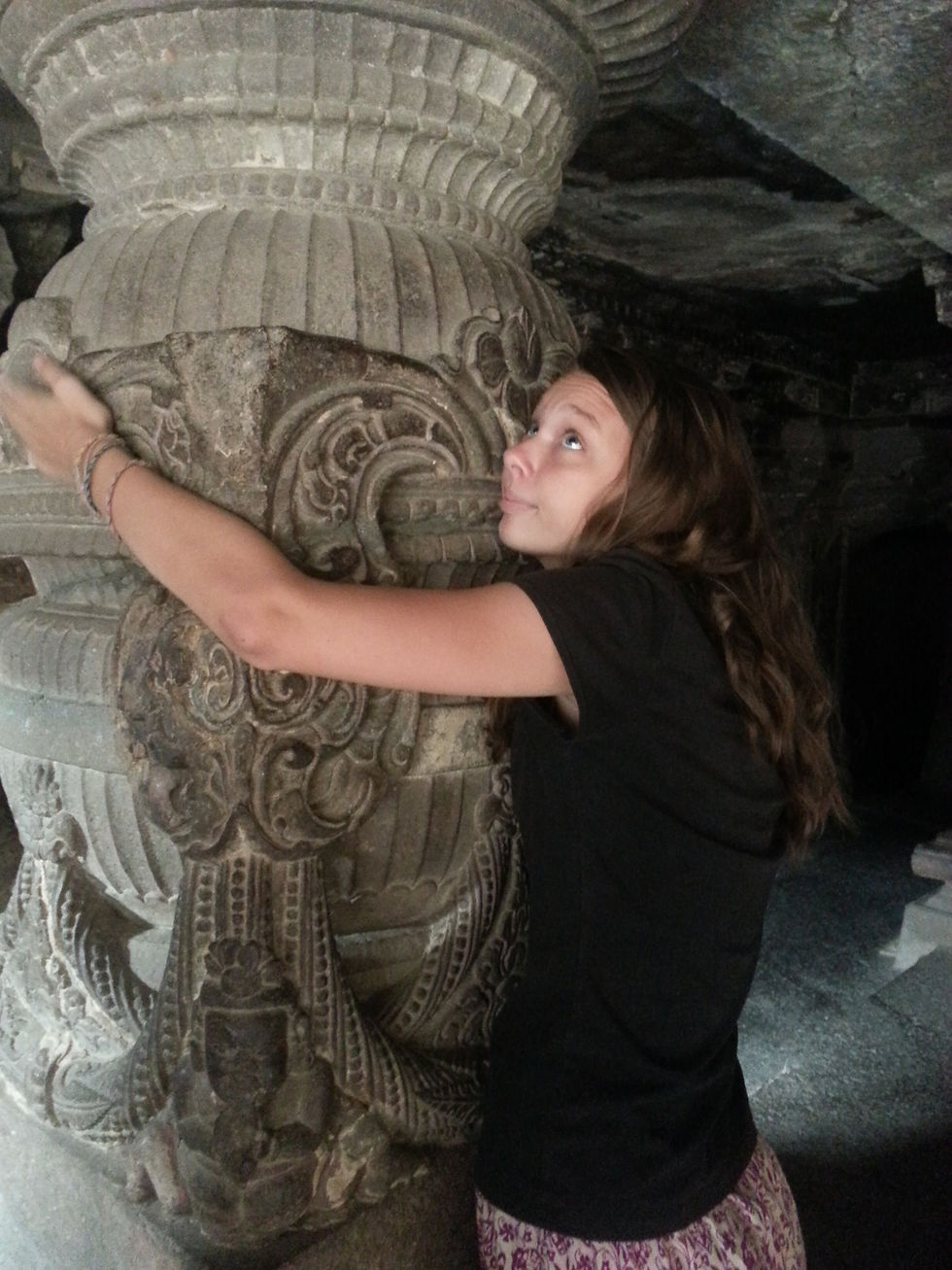Why You Need to Visit the Ellora Caves: The Best and Worst of India
- Rand Blimes

- May 11
- 5 min read

India: the Most of Everything
India doesn’t do middle-of-the-road. It doesn’t do average. It doesn’t do “pretty good.” Or “pretty bad.” No. India goes all-in with whatever it does.
The monuments? The most spectacular in the world.
The cities? The filthiest.
The food? The best.
The hygiene? The worst.
The colors? The brightest.
The poverty? The most overwhelming.
India was simultaneously the best and worst place we had ever been. The highs are higher. The lows are lower. India astounds you with its greatness, and makes you come to terms with its harsh reality.
India is not just more. India is the most.
And nowhere represented that to me more than Ellora.
A Visit to the Ellora Caves: Smacked Upside the Soul
Even if you’ve spent some time in India . . . even if you think you’ve started to “get it” . . . even if you believe nothing can surprise you anymore . . . India will come along and smack you upside the face with a reminder that you are never ready for everything it has in store.
I was taught this lesson—again—when I found myself standing in front of a mountain that someone had very politely—and very obsessively—hollowed out by hand over the course of hundreds of years.
Welcome to Ellora.
If you do a quick search, you’ll find that Ellora is a collection of caves.
But it’s not just a collection of caves. It’s a full-blown rock-carved civilizational flex.
Located a bit inland from Mumbai near the city of Aurangabad, the Ellora cave complex features 34 caves that were slowly chiseled out between the 6th and 10th centuries. And these aren’t natural caves. People dug into a mountain and made caves. And not just caves—temples, statues, entire mythological scenes carved out of stone.
And here's the part that absolutely delighted me: these caves were created by Buddhists, Hindus, and Jains—side by side—each carving their devotion into the same stretch of basalt cliff like spiritual neighbors borrowing sugar (or sandstone) from one another.

The Mountain That Became a Temple
The undisputed star of the show is Cave 16, also known as the Kailasa Temple—a structure so ludicrously ambitious that it was carved top-down from a single rock. That’s right. No stacking blocks. No laying foundations. Just: here’s a mountain, now start sculpting downward and don’t mess up.
It’s a temple.
It’s a sculpture.
It’s like a mountain that decided to reinvent itself as a monument to the human imagination.
It’s one of those places that makes you stop and whisper, “Humans did this?”
And the answer is: Yes. And then they kept going.

From Mumbai to Aurangabad: Into the Heart of Darkness
It’s relatively straightforward to get from Mumbai to Aurangabad, the gateway to Ellora. The train ride takes about seven hours—so it should make for a nice overnight ride.
In theory.
Our train left Mumbai around 9:00 p.m. and pulled into Aurangabad at the soul-wilting hour of 4:00 a.m.
We did not fancy sitting on a curb until check-in time, so we actually booked a hotel room for the previous night, allowing us to head straight to our beds upon arrival. Highly recommend.
As for the landscape between Mumbai and Aurangabad—well, let’s just say it felt like a full-on assault by humanity on nature. What wasn’t covered with concrete was strewn with rubbish. It looked post-apocalyptic.
Once we arrived, I peeked out our hotel window. The street in front of us was lined with shops. And behind them? A veritable ocean of garbage. Cats prowled like furry scavengers among the clouds of flies. What were they hunting? I didn’t ask.
We had one thought as we surveyed the unsanitary conditions near the only street with restaurants:
We’re going to get sick.
Spoiler alert: We did. All of us.
A Temple Carved from a Dream
All the caves at Ellora are impressive. Every single one of them.
But then you step into the Kailasa Temple . . .
And your brain just kind of . . . short-circuits.
The place is huge. Like, ridiculously huge. It’s a full-sized temple carved from a single mountain. Not constructed—carved. Out of solid rock.
You can walk around the temple. Through it. On it. Under it. And no matter how many angles you try, the question remains:
How did humans do this?
I mean . . . I don’t know. You just need to go to the Ellora caves.
I’ve seen Angkor Wat.
I’ve seen Machu Picchu.
I’ve seen the Pyramids of Giza.
Ellora is the most impressive thing I have ever seen.
You don’t just look at Ellora. You experience Ellora. And it changes your sense of what humans are capable of.

The Absurdity of the Indian Selfie
The five of us stood there, gazing up at the carved temple. We could feel the importance of this moment, standing there in the presence of an absolute monument to human ingenuity and tenacity.
And then, people started taking pictures. Of us.
Let me start by saying one of the things that makes India an absolutely fantastic destination for the traveler is that there may be no place in the world where it is as easy to meet locals as India. People are friendly. And curious. And they are interested and curious about foreigners who visit India. SO it is the simplest thing in the world to strike up a conversation with any random person you find yourself standing next to in India.
And all that curiosity, it means that just about even person in India would like to get a picture with you. All of them.
Standing there under the masterpiece at Ellora, a young man stepped up to us and asked us if he could get a picture with us. We were used to this by this point, and we even enjoyed it. So we said yes. And we posed with him.
And others in the area saw us taking a picture with him.
And they formed a queue.
To take pictures of my family.
Not the temple behind us. They made a line to take pictures of us.
At some point, we just had to announce that the next picture would be our last picture. Otherwise, we would probably still be there today.

Our Family’s Temple
Because travel has always had a hold on me, I had given the name Ellora to Daughter 2. Long before we ever visited the place.
So visiting Ellora carried a special weight for our family. It was a name come to life. A place that felt personal before we even arrived.
But let me be clear: you don’t need a daughter named Ellora to appreciate this place.
Seriously.
You need to visit the Ellora caves.
To see some of the best that India has to offer.
And, while you’re at it, you’ll also happen to see some of the worst.



Comments